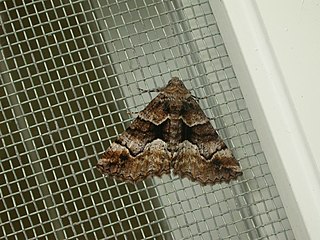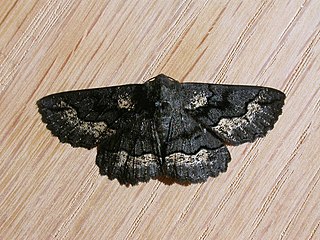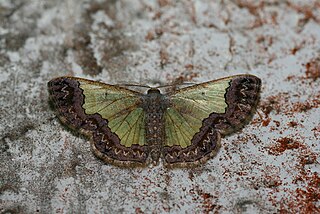
The geometer moths are moths belonging to the family Geometridae of the insect order Lepidoptera, the moths and butterflies. Their scientific name derives from the Ancient Greek geo γῆ or γαῖα "the earth", and metron μέτρον "measure" in reference to the way their larvae, or "inchworms", appear to "measure the earth" as they move along in a looping fashion. A very large family, it has around 23,000 species of moths described, and over 1400 species from six subfamilies indigenous to North America alone. A well-known member is the peppered moth, Biston betularia, which has been subject of numerous studies in population genetics. Several other geometer moths are notorious pests.

The Hepialidae are a family of insects in the lepidopteran order. Moths of this family are often referred to as swift moths or ghost moths.

Alexander Walker Scott was an Australian entomologist mainly interested in butterflies.

Acronicta is a genus of noctuid moths containing about 150 species distributed mainly in the temperate Holarctic, with some in adjacent subtropical regions. The genus was erected by Carl Linnaeus in his 1758 10th edition of Systema Naturae. Caterpillars of most Acronicta species are unmistakable, with brightly colored hairy spikes, and often feed quite visibly on common foliate trees. The hairy spikes may contain poison, which cause itchy, painful, swollen rash in humans on contact. The larva of the smeared dagger moth is unusually hairy even for this genus. Acronicta species are generally known as dagger moths, as most have one or more black dagger-shaped markings on their forewing uppersides. But some species have a conspicuous dark ring marking instead.

Ugia is a genus of moths in the family Erebidae erected by Francis Walker in 1858.

Circopetes is a monotypic moth genus in the family Geometridae erected by Louis Beethoven Prout in 1910. Its only species, Circopetes obtusata, the grey twisted moth, was first described by Francis Walker in 1860. It is found in mainland Australia.

Gastrina is a monotypic moth genus in the family Geometridae. Its only species, Gastrina cristaria, the wave-lined geometrid, is found in the south-eastern quarter of Australia. Both the genus and species were first described by Achille Guenée in 1857.
Lophosis is a monotypic geometrid moth genus. Its only species, Lophosis labeculata, the stained lophosis moth, is found in North America. Both the genus and species were first described by George Duryea Hulst, the genus in 1896 and the species in 1887.

Melanodes is a monotypic moth genus in the family Geometridae. Its only species, Melanodes anthracitaria, the black geometrid, is found in Australia, more specifically in southern Queensland, New South Wales, Victoria, South Australia, and Tasmania. The genus and species were described by Achille Guenée in 1857.

Niceteria is a monotypic moth genus in the family Geometridae erected by Alfred Jefferis Turner in 1929. Its only species, Niceteria macrocosma, the showy geometrid, is found in Australia. It was first described by Oswald Bertram Lower in 1899.

Plataea is a genus of geometrid moths in the family Geometridae. There are about 11 described species in Plataea.

Zamarada is a genus of moth in the family Geometridae, first described by Moore in 1887. The species type is Zamarada translucida. Over 250 species and 35 subspecies have been listed.

Sterrhinae is a large subfamily of geometer moths with some 3,000 described species, with more than half belonging to the taxonomically difficult, very diverse genera, Idaea and Scopula. This subfamily was described by Edward Meyrick in 1892. They are the most diverse in the tropics with the number of species decreasing with increasing latitude and elevation.

Psilogramma casuarinae, the Australasian privet hawk moth, is a moth of the family Sphingidae. The species was first described by Francis Walker in 1856. It is known from New South Wales, the Northern Territory and Queensland, all in Australia.

Tiracola plagiata, the cacao armyworm, is a moth of the family Noctuidae. The species was first described by Francis Walker in 1857. It is found from south-east Asia, South India, Sri Lanka, Myanmar to the South Pacific Islands, including the northern two-thirds of Australia.

Tifama is a monotypic moth genus in the family Notodontidae erected by Francis Walker in 1855. Its only species, Tifama chera, was first described by Dru Drury in 1773. The species is known from Suriname and Brazil.
Plataea californiaria is a species of geometrid moth in the family Geometridae. It was described by Gottlieb August Wilhelm Herrich-Schäffer in 1856 and is found in North America.
Homochlodes disconventa is a species of geometrid moth in the family Geometridae. It was described by Francis Walker in 1860 and is found in North America.
Parilexia is a genus of geometrid moths in the family Geometridae. There are at least three described species in Parilexia.
Adrapsa geometroides is a moth of the family Noctuidae first described by Francis Walker in 1858. It is found in Indian subregion, Sri Lanka. to Sundaland and New Guinea.















